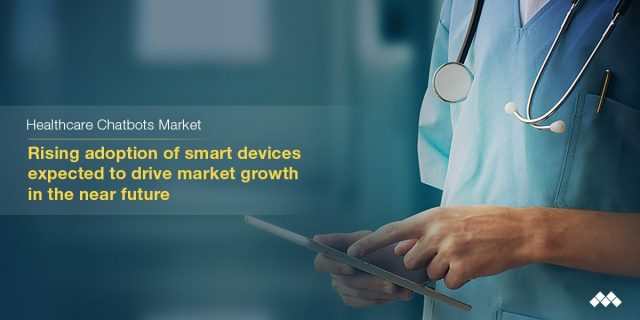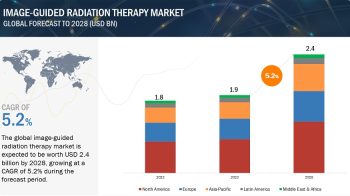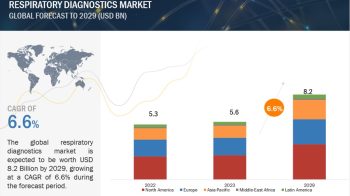
Rising Internet connectivity and the growing adoption of smartphones and mobile platforms play a key role in ensuring the adoption and use of chatbots. This has ensured growing numbers of consumers to access healthcare services, and also greatly broadened the reach of said services.
According to data published by Anthem Insurance Companies, Inc. (US) in May 2017, around 52% of smartphone users gather health information using mobile apps; 36% of doctors say apps are the most effective way to engage with patients; and 93% of doctors believe mobile apps can improve health. Smart devices equipped with advanced chatbot tools solve many mission-critical communication issues in healthcare. Thus, an increase in overall smartphone and device adoption will favor the growth of the global healthcare chatbots industry.
The global healthcare chatbots market is projected to reach USD 314.3 million by 2023 from USD 122.0 million by 2018, at a CAGR of 20.8% from 2018 to 2023. The growth of the healthcare chatbots market is mainly driven by rising Internet connectivity and smart device adoption, company initiatives to boost the healthcare chatbots, and the need for virtual assistance The report segments the healthcare chatbots market by component, deployment model, application, end user, and region.
Based on component, the healthcare chatbots market is segmented into software and services. The software segment is expected to account for a larger share in 2018 as compared to the services segment. Enhanced technological features in chatbot software, such as Natural Language Processing (NLP), multilingual capabilities, interference engine, cloud-based deployment, Application Programming Interface (API), mobile platform compatibility, and single point of search is propelling the growth of the software segment.
Growing usage of healthcare chatbots by clinicians and hospitals to increase their patient engagement rate, are driving the growth of the healtchcare chatbots market.
Download PDF Brochure @
https://www.marketsandmarkets.com/pdfdownloadNew.asp?id=27837519
Patients
Patients are the largest end users of healthcare chatbots. Patients use applications such as symptom checkers and medical triage applications to understand their conditions better. They can access healthcare chatbots on medical websites, mobiles, and on social media pages, and then interact with virtual healthcare assistants to receive the appropriate healthcare information based on symptoms. Healthcare chatbots interact with potential patients visiting a site, provide a possible diagnosis, help find specialists, schedule appointments, and improve access to the right treatments. The adoption of medicine assistant chatbots such as Florence and Melody is also increasing as these bots notify patients to take their medication on time and also report data in case of a missed dosage.
Healthcare Providers
Healthcare providers include healthcare organizations, clinicians, and physicians. Healthcare providers need to identify diseases and analyze a large amount of healthcare information to make critical decisions. In an effort to improve the quality of care and reduce costs, healthcare providers are increasingly turning to IT-enabled strategies and software for the appropriate identification of diseases and better treatment alternatives. For instance, the SafeDrugBot is a chatbot widely used by doctors to find safe drugs that can be administered to pregnant women and mothers that are breastfeeding.
Insurance Companies
Insurance companies require access to medical information to guide clients and employees towards appropriate medical care so that they can avoid unnecessary medical costs. Owing to this, there is an increasing demand for healthcare chatbots such by insurance companies to analyze healthcare payment. To address this demand, chat providers are entering into collaborations with insurance companies or launching specially designed products for insurance providers. Such strategic developments will help chatbot providers to offer technologically advanced products for the insurance companies market, expand their customer base, and cater to the unmet demands of their customers.
Other End Users
Other end users include medical assistance provider companies, pharmacies, and third-party organizations. These companies majorly use healthcare chatbots to provide potential patients with proper access to healthcare information and help them find appropriate healthcare treatments in case of medical emergencies.
Request for Sample Pages @
https://www.marketsandmarkets.com/requestsampleNew.asp?id=27837519
Concerns regarding data privacy pose a major challenge for the market. Chatbots are used for various applications in healthcare industry. Chatbots use software that applies AI to process language from interactions between humans and virtual assistants. As chatbots are actively being implemented, data security & privacy is one of the major challenges faced by the market. Patient data contain personal, private, or confidential information and requires strict safeguards to prevent its misuse.
Patient data is protected under federal laws in many countries, and any breaches or failures to maintain its integrity can result in legal and financial penalties. Since chatbots used for patient care require access to multiple data sets, it is mandatory for AI-based tools such as chatbots to adhere to all data security protocols implemented by government and regulatory authorities. This is a very difficult task as most AI-based platforms are consolidated and require extensive computing power owing to which patient data, or part of it, can be required to reside in a vendor’s data set.
The healthcare chatbots market is marked by the presence of several established as well as emerging players. Prominent players offering healthcare chatbots are Your.MD (UK), HealthTap, Inc. (US), Sensely, Inc. (US), Buoy Health, Inc. (US), Infermedica (Poland), Babylon Healthcare Service Limited (UK), Baidu, Inc. (China), Ada Digital Health Ltd. (Germany), PACT Care BV (Netherlands), Woebot Labs, Inc. (US), and GYANT.Com, Inc. (US).


